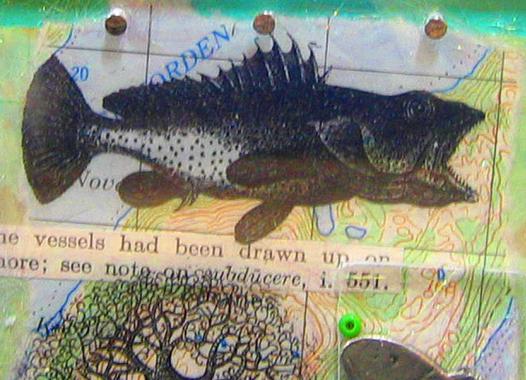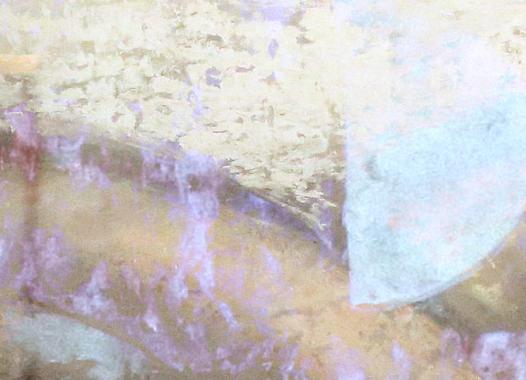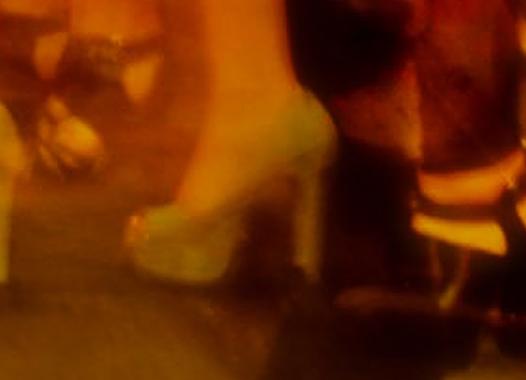
These are exceprts from Timothy Griffiths “The Other Side is Opening Now”
Gaga can’t handle this shit.
- Death Grips, “Hacker”
“Non-Family Safe”
In February of 2012, Mike Hadreas, known by the moniker “Perfume Genius,” released his second album, Put Your Back N 2 It[1], through Matador Records. As part of the marketing of the album, Matador created a fifteen-second promo to run before certain YouTube videos. The footage in the promo is taken from the video for Hadreas’ song “Hood” (https://www.youtube.com/watch?v=OOpkr8uNWpk), but it is paired with music from a different song entitled “All Waters” (https://www.youtube.com/watch?v=2ytGTtn7q5c). The brief ad is composed of Hadreas awkwardly hugging the Greek porn star Arpad Miklos. The two men are stripped down to their underwear, contrasting Hadreas’ body — waifish, white, and smooth — and Miklos’ — olive-skinned, muscular, and hirsute. The somber nature of this pseudo-sexy clip is further underscored by the lyrics from “All Waters,” which touch on internalized homophobia and the singer’s hesitation to hold his partner’s hand in public. Despite its tameness, this promo was rejected by Google and YouTube because
Any ads that contain non-family safe material are disapproved. [Although] the people in the video are not entirely unclothed, [the] overall feeling of the video is one of a more adult nature, including promoting mature sexual themes and what appears to be nude content. As such, the video is non-family safe. In order to have this video ad approved, you will need to bring it into compliance with our policy. (qtd. in Pelly)[2]
Google’s rejection of Matador’s advertisement garnered more publicity for Perfume Genius than the promo alone would have. Within days, the story of the rejection spread, not just on indie-centric online music zines like Pitchfork, Free Williamsburg, and Prefix, but on Dan Savage’s The Stranger and, most notably, The Huffington Post’s “Gay Voices” section. In a time when “online outrage” helps websites like these sell ad space, a controversy like this one, with its easily targetable homophobia, created a publicity generating relationship between all parties involved, transforming Hadreas from an underground singer of sensitive bedroom balladry into a “gay voice.”
Yet this anointment is incongruous with what we know about gay politics in the social-media age. Consider the Perfume Genius promo side-by-side with Dan Savage and his partner Terry Miller's “It Gets Better” video. The popularity of “It Gets Better” videos arguably makes them the dominant representation of LGBT experience on YouTube and elsewhere. The clip takes a typical format for these videos in which, sitting shoulder-to-shoulder, the two men describe the various instances of bullying and abuses they experienced as teenagers and then implore LGBT teens not to commit suicide because “it gets better.” They describe their parents’ eventual acceptance of them, their meet-cute in a gay dance club, their adopted son, and a “happy memory” about their first trip to Paris. This unfortunately paints a specific picture of the gay good life that is contingent on its subjects’ white-maleness and socioeconomic privilege, its limited tropology of being implying that it only gets better under certain circumstances that for most are unattainable. Dan Savage and his partner’s story is the sort of exemplary promise of the good life Lauren Berlant has notably critiqued in her influential 2011 book Cruel Optimism. Chase Dimock, in his review of Cruel Optimism for Lambda Literary, deftly explains how Berlant’s definition of “Cruel Optimism” — “when something you desire is actually an obstacle to your flourishing” — describes the troubled arc of progress in LGBT politics: “Thirty years ago, the thought of marriage, adoption, and serving openly in the military was the dream of the boldest of optimistic LGBT activists. Now that this dream is becoming an approachable reality for some, will they find that this aspiration toward a domestic norm is a form of cruel [optimism?]” Dominant LGBT political projects like the “It Gets Better” narrative keep marginalized people working within outworn heteronormative paradigms rather than against them. Homophobia is depicted as something that must be “toughed out” through passivity and blithe optimism, its negative effects ultimately overcome by economic success.
By comparison, the video for “Hood” offers little in the way of promises. It instead focuses on an ephemeral, uneven, and markedly forced embrace between a porn actor (who would tragically commit suicide via drug overdose a year later) and a scrawny piano balladeer. With the emergence of the controversy surrounding the YouTube promo, the interconnected thematics of PYBN2I’s lyrics — pornography, child abuse, alienation, animality, anal sex, and bathhouses, to name a few — as well as its challenging blend of lo-fi ambient wash and sensitive piano balladry, were brushed aside by most in favor of more easily digestible gay thematics. The album itself is not in fact “family safe,” insofar as it does not valorize the heteronormative nuclear family as central to human experience.[3] It is, therefore, also not adaptable as iconography for gay politics since it does not stick to the tropology of power and affirmation idealized in the icon of the homonormative family.
Hadreas cannot and will not be a “gay voice,” preferring a somewhat cavalier or playful attitude toward the melodrama of homonormative politics. When Hadreas hugs Miklos in the promo and in the video for “Hood,” he does not promote marriage per se, but instead marries internalized homophobia, mainstream popular media, performance art, bodily aesthetics, and gay kink in a way that entangles the most visible formations of gay politics with Hadreas’ provocative sensibilities. With Put Your Back N 2 It, Hadreas has sited his work at the nexus of gay political iconicity, queer ecology, and what I will refer to here as wildness.
PYBN2I explores the aesthetic tendencies and hermeneutics of wildness — a concept I will further elucidate in the following section — as an opportunity to go in various directions and into different political spaces all at once, rejecting the notion that queer antinormativity and polite political expression are mutually exclusive sites for the acquisition of queer pleasure and rights. This article — which is influenced by and also briefly addresses the theoretical work of Timothy Morton, Karen Barad, and José Esteban Muñoz, among others — focuses on gay politics and queer experience as they are portrayed in Hadreas’ music. I suggest that PYBN2I has not engendered a normalization or whitewashing of queer wildness and radicalism, nor is it entirely subversive. Rather, it is an example of how radically traversing the homonormative and queer/wild political scene(s) both enlivens stale gay political tropologies and revises them to put experimental queer aesthetic tendencies in high relief.
By reviewing Perfume Genius’ aural and visual work on PYBN2I and noting a relationship between this work and recent discourse on haptics, nature, and ontology, I suggest that Hadreas’ appeal to ontological query through the metaphoric and literal touch sense relates the chaotic landscape of gay politics to the multiplicities of queer experience. This work is necessary for two reasons: first, it draws an aloof, antirelational vein of queer radicalism into closer contact with gay political symbology, forcing it to contend with dominant culture in a productive and deliberate fashion; second, it appropriates gay political symbology to draw attention to the most marginalized and underrepresented elements of LGBT life.[4]
Wild Theorization and Political Visibility
In the spirit of José Esteban Muñoz’s Gramscian insistence in Disidentifications that performers are philosophers and performance is the practice of philosophy (110-11), it is my intention to let the theorizations at play here issue primarily from Put Your Back N 2 It and its surrounding media. Concurrently, I map crucial analogic relationships between the work being done on PYBN2I and recent queer thought that is roughly organized around a phenomenological or ecological turn. Although these latter queer discourses provide an important context for it, Hadreas’ work itself makes clear the stakes of queer wildness by depicting the rather wide gap between dominant iterations of gay personhood and the potentiality of lived experience catalyzed by the album’s forays into something like ecological consciousness and willed entanglement. But before connecting these streams of thought, I recognize the need for a few clear terminological definitions and some contextualization on recent turns in queer theory and their stakes.
I draw the notion of a “queer wild” from a queer theory seminar I took in the performance studies department at NYU with Profs. José Esteban Muñoz and Tavia Nyong’o. In the class, notions of a “queer wild” — expressed often as the culture of the socioeconomic undercommons, forms of animality, types of sexual relationality that flout rules, or forms of dance and movement — were simultaneously celebrated and interrogated as, respectively, the refreshing antitheses to modern LGBT respectability politics and imaginative but conceptually slippery political actions. A particularly notable catalyst of this discourse comes from filmmaker Wu Tsang’s documentary Wildness, a film about a working class Los Angeles gay bar called The Silver Platter that plays host once a week to a transgender performance art event called “Wildness.” The film, in short, depicts the bar as a space for liberatory performances of sex and gender facilitated through less politely rendered forms of gesture and interclass, interracial sociality than what is possible in the daytime world. It also frankly portrays the tensions that arise between the bar’s regular patrons — mostly gay men of color — and the transgender performance artists. This inter- and intra-group sociality suggests not that “Wildness” is some kind of romantic utopianist paradigm, but that it is a kind of queer world-making that puts marginalized queer people in contact with the principles and considerations of more dominant and visible iterations of LGBT political embodiment. It is, in this regard, one of many recent works that challenges the stability and value of what is known in LGBT and other social discourses as the “safe space.”[5]
Conversely, and perhaps reductively, the notion of a “gay household” is best exemplified by the Dan Savage “It Gets Better” video described earlier in the essay. The household acts as a framework for gay experiences and political viabilities tied to material affluence, cosmopolitanism, and normative white-maleness. This “mainstreaming” of gay culture and its discontents is often described as “homonormativity,” a term liberally employed by Michael Warner in his powerful 1999 polemic against marriage, The Trouble with Normal. Warner’s book critiques the notion that marriage equality ought to be the central political concern of gay activism because of the institution’s history as a technology of gender oppression. Other critiques of homonormativity, such as those found in the 2010 collection Queer Ecologies, make the case that gay political viability is literally purchased through good consumerism at the expense of, among other things, ecological sustainability (22). Many texts about homonormativity, in fact, share a fundamental trait with ecocriticism —the vociferous critique of mindless consumption, rationalized by the necessity of accretive self-actualization for modern subjects. As I discuss in what follows, this album’s various treatments of the concept of “wildness,” whether as anti-societal critique, unpredictable movement, unbridled physicality and touch, or ecological reclamation and rethinking, do not only suggest ways of queer being that are exterior to homonormativity, but link those ways of being with the tropology of dominant gay subjecthood rather than ignoring it altogether. Along the way, this essay elucidates the treatments of queer wildness on PYBN2I with the work of other theorists involved in the nascent discourse of queer ecology; this discourse uses various values and concepts of queer theory to challenge the heteronormativity of modern environmentalism while also using posthumanist ideas about the concept of nature and the human/animal divide to destabilize queer theory’s insistence on social constructivism and postmodern humanism as its sole theoretical foundations.[6] Making these connections is not an intention to validate or authorize the work being done on PYBN2I with academic discourse, but to fully illuminate its conceptual reach, its interlocutors, its successes, and its limitations.
***
[...] The penultimate song on the album, “Floating Spit,” tests the political coherence of the album as a way of making the lives of gay men illegible from the outside. Instead of more revisions of familiar gay tropologies, juxtapositions of political affect, or utopian sexual ideology, the song — sounding something like a mix between Phil Collins’ “Something in the Air” and Enya — instead offers drone-like synths and a simple six-line verse: “Peel off the color / of the night / a second skin, a floating spit / is hovering / the other side is opening now / I don’t think that I can hold it.” Coming as it does penultimately, this song offers a tentatively epiphanic moment for its singer within the loosely narrative album wherein he trades his divided consciousness for an exciting yet challenging visceral feeling. The singer, rather than acquiescing to the political viability of the album’s ostensible mission statement — “Put Your Back N 2 It” — instead describes a mystical vision of the afterlife or another world. The sky’s color gives way to something like a membrane that surrounds the human world, much like a second skin or saliva coating the sky, teeming through the air. The membrane becomes permeable, opening onto an “other side.” The singer, however, cannot hold onto this other side’s mystical, romantically “natural” qualities, nor can he touch them. He is instead pulled back into the world, under the night, and back into his body. There are links here between the mystical imagery and sexuality. The second skin/floating spit is evocative of the promise of certain condoms to be particularly conducive to enhanced sensitivity, acting almost as a lubricated second skin, floating over but not constraining sexual touch; it bars bodily fluids, but allows for slippery friction. When it opens, the singer is not quite sure he can handle the unbridled feel of skin-on-skin contact. Since this song dually signifies as both a song about the world falling away and a condom breaking — and surely it can produce many other interpretations[14] — it resists giving the body of the queer over to the world. Instead, it describes an aporia wherein the humanity of queer lives cannot undergo rites of subjecthood without prophylactic layers between queerness and the rest of the human world; this prophylactic boundary could include compulsory hesitation before public affection (“All Waters”), shame about sexual desire (“AWOL Marine”), or hatred of one’s own body (“17”). “Floating Spit” puts the queer body beside and in touch with the symbolic constraints and implications of the rest of the album, allowing for one moment where it signifies wildly and without direction. Much like on “All Waters,” there is no single implied destination or political directionality; there is only Hadreas and the ether, but he cannot “hold it.”
“Floating Spit” marks the moment in PYBN2I when the album makes its most emphatic declarations about the usefulness and value of queer radicalisms, queer wildness, and erotic entanglement as liberating paradigms. Certainly there is a way that this — along with “All Waters” and the video for “Dark Parts” — can be read as texts that elevate a certain “more alternative” vision of queer life (via ecological consciousness) as an escape from the constraints of gay political subjectivity. The album, however, does not let go of a depiction, discussion, and dissection of all the traumas and other conditions that have made the projection of a gay political subjectivity necessary for the attainment of certain rights and privileges. What is more, the protagonist of the “Dark Parts” video does not seem to be quite through with gay political iconography in favor of or as diametrically opposed to queer wildness. Hadreas never claims on the album that everyone must go wild to become free; decidedly, the album shows much more ambivalence about that philosophy than even Timothy Morton suggests, and in that sense, PYBN2I offers a much more well-considered and thoughtfully packaged version of queer ecology’s value than most actual queer ecological theory does. By depicting wild entanglement not as an escape from normative values, but as something that heavily involves an entanglement with dominant culture, Hadreas’ album avoids becoming another entry in the punkish, antirelational genealogy of artists like Xiu Xiu or queer theorists like Lee Edelman and Michael Warner. Hadreas’ work is not about the abject disentanglement of gay men from dominant heterosexual culture. Instead — in the vein of thinkers like José Esteban Muñoz — Hadreas’ album holds dominant culture close as something to be concurrently spurned, grappled with, inhabited, and compulsorily rehabilitated. It offers, rather than an escapist vision of wild sexual liberation, a depiction of some space where the dominant domestic and the emergent wild are — if you will entertain a fanciful metaphor — fucking and fighting all at once. It is an album that attempts to peel away at the lamination (without dispensing with it entirely) that surrounds queer political being, an album that touches gay political iconography and becomes invested with it as a multitudinous, entangled other.
Notes
[1] Henceforth referred to as “PYBN2I.”
[2] This e-mail was tweeted by Matador Records’ Twitter page, but later deleted.
[3] Although there is a plethora of work on these concepts, I am mostly drawing from Lee Edelman’s No Future wherein he polemicizes against what is now commonly known as “reprocentrism,” the privileging of reproductive nuclear families in modern aesthetics and culture.
[4] Let me briefly explain how my work builds on the December 2013 JPMS “Trans/Queer” issue. Lucas Hilderbrand’s essay, “‘Luring Disco Dollies to a Life of Vice’: Queer Pop Music’s Moment,” looks at a formative time in the history of queer pop music, namely 1981, as a year when subcultural music such as punk and pop music tread similar ground with regard to queer subject matter. Hilderbrand claims that this promoted fluidity in what both popular music about queerness as well as queerness itself could be, a fluidity he argues has been lost in the rush to consensus LGBT culture (431). I am inspired by the work this essay does to try to mark a similar fluidity in queer culture at the present moment exemplified by the very wide ideological gap between LGBT-interested music by allies (Lady Gaga, Macklemore) and music by artists like Perfume Genius or Xiu Xiu, a fluidity that is occurring perhaps because of the rapid co-optation of LGBT politics by mainstream America. One might argue that 1981 and 2014 are not such different political moments for LGBT people. In the essay, “Between Silence and Stigma: Notes on Jamie Stewart’s Queer Performativity,” Victor Szabo explores the way in which Jamie Stewart of Xiu Xiu uses his music to “loudly [explore] various ways of publicly inhabiting one’s abjection” (439). Reading Szabo’s work helped me to theorize Perfume Genius’ similar impulses and depictions of how one can inhabit abjection rather than disavow it as an aspect of queer experience.
[5] For an excellent critique of “safe space” and “trigger warnings,” see J. Jack Halberstam’s “You Are Triggering Me! The Neo-Liberal Rhetoric of Harm, Danger and Trauma.” Halberstam, among others, has done important (though still informal) recent work critiquing the conditions of “safe space” as being predicated on an assumption of people’s triggers via outdated, always already pre-formed political subjectivities. This has bearing not only on pedagogy, but inspires the kind of ethos that drives my own analysis of Perfume Genius, one that assumes that grappling with the aggravating, annoying, limiting, or even hurtful aspects of dominant political subjectivity is part and parcel of being an engaged queer scholar, something very different from actual trauma.
[6] While I have found the work of Morton, Barad, and Muñoz the most relevant to the work done here, I would be remiss not to mention a few other key figures in queer ecology and what they have lent to its development. Robert Azzarello’s Queer Environmentality and Nicole Seymour’s Strange Natures have been pivotal texts in reexamining the heteronormative tendencies and Darwinian reproductive thought so prevalent in ecocriticism and in correcting it through depictions of queer experience and being as an important form of radical environmentalism and eco-thought; further, these texts, among others, have tried to reclaim Darwinian thought as itself queer via its emphasis on the indeterminacy and unpredictability of biological success. Catriona Mortimer-Sandilands and Bruce Erickson’s Queer Ecologies, an edited collection, has not only been effective as a demonstration of what kind of work can be done under the rubric of queer ecology, but rightly diagnosed many of the problems with queer theory that could be addressed by ecocriticism. Most specifically, in the introduction to the collection, Mortimer-Sandilands and Erickson suggest that eco-sexual resistance is in line with queer refusal of the dominant imprint on mainstream gay politics, which is full participation in hyper-consumerist culture masquerading as “acceptance” (22).
[14] Hadreas, for instance, claims that the song is about “overdosing and going to the other side … Neverending Story … in a bathhouse.” See note 13.
Works Cited
Azzarello, Robert. Queer Environmentality. Surrey, England: Ashgate, 2012. Print.
Barad, Karen. “On Touching – the Inhuman That Therefore I Am.” Differences 23.3 (2012): 206-223. Print.
---. “Posthumanist Performativity: Toward an Understanding of How Matter Comes to Matter.” Signs 28.3 (2003): 801-31. Print.
Bennett, Jane. Vibrant Matter. Durham: Duke University Press, 2010. Print.
Berlant, Lauren. Cruel Optimism. Durham: Duke University Press, 2011. Print.
Butler, Judith. Bodies That Matter. New York: Routledge, 1993. Print.
“Dark Parts.” Dir. Winston Case. Perf. Perfume Genius. YouTube, 2012. Music Video. http://www.youtube.com/watch?v=E5WNqvdIfJ8
Death Grips. The Money Store. Epic, 2012. MP3.
Dimock, Chase. “‘Cruel Optimism’ by Lauren Berlant.” in Lambda Literary. 30 July, 2012. http://www.lambdaliterary.org/reviews/07/30/cruel-optimism-by-lauren-berlant/
Derrida, Jacques, On Touching, Jean Luc Nancy. Trans. Christine Irizarry. Stanford: Stanford UP, 2005. Print.
Edelman, Lee. No Future. Durham: Duke UP, 2004. Print.
Fitzmaurice, Larry. “Perfume Genius: Put Your Back N 2 It.” in Pitchfork. 27 February, 2012. http://pitchfork.com/reviews/albums/16335-put-your-back-n-2-it/
Halberstam, Jack. “You Are Triggering Me! The Neo-Liberal Rhetoric of Harm, Danger, and Trauma.” in Bully Bloggers. 5 July, 2014. https://bullybloggers.wordpress.com/2014/07/05/you-are-triggering-me-the-neo-liberal-rhetoric-of-harm-danger-and-trauma/
Hilderbrand, Lucas. "‘Luring Disco Dollies to a Life of Vice”: Queer Pop Music's Moment." Journal of Popular Music Studies. 25.4 (2013): 415-438. Print.
“Hood.” Dir. Winston Case. Perf. Perfume Genius. YouTube, 2012. Music Video. http://www.youtube.com/watch?v=OOpkr8uNWpk
Morton, Timothy. The Ecological Thought. Cambridge, MA: Harvard UP, 2010. Print.
---. “Queer Ecology.” PMLA 125.2 (2010): 273-282. Print.
Muñoz, José Esteban. Cruising Utopia. New York: NYU Press, 2009. Print.
---. Disidentifications. Minneapolis, MN: University of Minnesota Press, 1999. Print.
Mortimer-Sandilands, Catriona, and Bruce Erickson. 2010. Queer Ecologies. Bloomington, Ind: Indiana University Press, 2010. Print.
Perfume Genius. Put Your Back N 2 It. Matador, 2012. MP3.
“Perfume Genius.” Matador Records. http://www.matadorrecords.com/perfume_genius
“Perfume Genius ad.” Dir. Winston Case. Vimeo, 2012. Advertisement. http://vimeo.com/35522448
Pelly, Jenn. “Matador Says Google/YouTube Rejected Perfume Genius Promo Video For Being ‘Not Family Safe.’” in Pitchfork, 24 January, 2012. http://pitchfork.com/news/45217-matador-says-googleyoutube-rejected-perfume-genius-promo-video-for-being-not-family-safe/
Sedgwick, Eve. Touching Feeling: Affect, Pedagogy, Performativity. Durham: Duke UP, 2003. Print.
Seymour, Nicole. Strange Natures. Urbana: University of Illinois Press, 2013. Print.
Szabo, Victor. "Between Silence and Stigma: Notes on Jamie Stewart's Queer Performativity." Journal of Popular Music Studies. 25.4 (2013): 439-458. Print.
Warner, Michael. The Trouble with Normal: Sex, Politics, and the Ethics of Queer Life. New York: Free Press. 2009. Print.
Wildness. Dir. Wu Tsang. Class Productions, 2012. Film.
Article information
Join the colloquy
Join the colloquy
Queer Environmentalities
more
Scholars working to bring these two fields together argue that each has undermined its central goals by keeping aloof from the other: That ecological criticism has been fundamentally unable to broach the concerns of queer theory when it has privileged a version of "natural" that foregrounds heteronormativity; and that queer theory, for its part, has had no room for a consideration of the environment because the liberatory impulse of queerness has gotten much of its momentum from the turn away from nature, the de-coupling of human choices from a reigning "natural" order. But, queer environmentalists ask: Can an ecocritical enterprise—one aimed at revealing and reversing the destruction brought about by human-centric conceptions of environment—hope for a success if it fails to take into consideration the injustices of imagining the human as male and heterosexual?
This Colloquy takes its title from Robert Azzarello’s 2012 book Queer Environmentality, in which Azzarello argues that a synthesis of ecocriticism and queer theory can reveal that "the questions and politics of human sexuality are always entwined with the questions and politics of the other-than-human world." Criticism that attends to our queer environmentalities can enable profound resistances to, as Azzarello puts it, "conventional notions of the strange matrix between the human, the natural, and the sexual." Such approaches can reveal the Anthropocene as not only a period in which humankind has altered nature, but also as a period in which humankind has constructed the definitions of nature, and can throw into relief unarticulated valuations of scientific discourse and identity politics in making humans’ relationships with the non-human mean.
Since their budding in the 1990s in the pioneering work of ecofeminist critics such as Catriona Sandilands and Greta Gaard, queer-ecological methods have gained momentum across humanistic disciplines, periods, and national boundaries. This Colloquy highlights exciting new work in literary and cultural histories and presents dance and performance, film, music, urban studies, and political ecology. It showcases a range of approaches, from postcolonial to trans theory, to objects of study spanning our aesthetic productions and our political, economic, and rhetorical responses to the challenges of managing climate change and natural resources. The pieces featured here expand conceptions of environment and sexuality to include the human(-made) and the non-human, the intersections of bodies' outsides and insides, minds and discourses, making possible new ways to think filiation and affiliation, desire and sex, realisms and un-realisms, aesthetics and politics.















